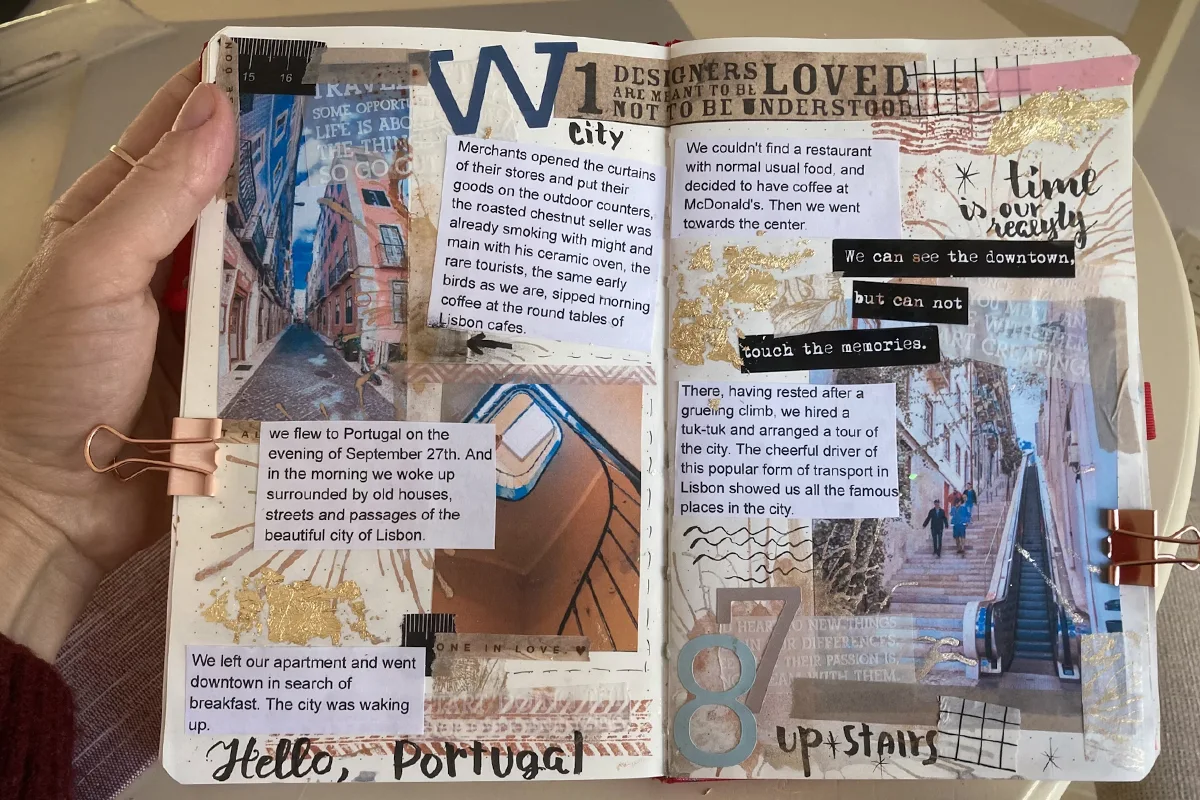Decided to write your own travel journal during your next vacation? Whether you're a solo wanderer, a student on an educational adventure, or simply someone with an unquenchable thirst for new experiences, keeping a travel journal will surely enrich your journey in profound ways. To help you document your travels with depth and creativity, here are over 100 prompts tailored for solo travelers, students, and adventurous souls.
25+ Journaling Prompts for Solo Travelers:
• Describe a moment when you felt completely at ease in a foreign land.
• Write about a serendipitous encounter you had with a local.
• Reflect on a place you visited that challenged your perceptions.
• Detail a solo adventure that pushed your limits.
• Capture the sights, sounds, and scents of your favorite local market.
• Write a letter to yourself about what you've learned during solo travels.
• Describe a cultural tradition that left a lasting impression on you.
• Sketch or write about a breathtaking view you stumbled upon unexpectedly.
• Share a story of how a mistake led to an unforgettable experience.
• Reflect on the concept of 'home' while being away.
• Describe a meal that symbolizes the essence of a particular destination.
• Write about a local artist or artisan whose work fascinated you.
• Document the feeling of freedom that comes with solo exploration.
• Reflect on the contrasts between solitude and loneliness during your travels.
• Detail a local festival or celebration you were lucky to witness.
• Write about a personal transformation or realization during your journey.
• Describe a memorable conversation you had with a fellow traveler.
• Capture the beauty of a sunrise or sunset in your journal.
• Reflect on a moment that made you appreciate the kindness of strangers.
• Share your thoughts on the concept of time in a new culture.
• Write about a place that made you feel most alive.
• Detail the quirkiest aspect of a destination that amused or surprised you.
• Reflect on the challenges and joys of navigating a new language.
• Describe a spontaneous decision that led to an incredible experience.
• Capture the essence of a place through its unique soundscape.
25+ Journal Prompts to Capture Local Experiences:
• Detail the local folklore or legends you encountered.
• Write about a hidden gem or off-the-beaten-path location you discovered.
• Capture the aroma and flavors of a traditional dish.
• Describe the architecture that defines the area.
• Document the local wildlife or plants unique to the region.
• Reflect on the historical significance of a particular site or monument.
• Write about a local festival or celebration and its significance.
• Detail the local customs or traditions that intrigued you.
• Capture the hustle and bustle of a busy street or market.
• Write about a cultural etiquette you learned and practiced.
• Describe the craftsmanship of local artisans and their creations.
• Reflect on the role of spirituality or religion in the community.
• Detail a conversation you had with a long-time resident.
• Capture the daily rhythms of life in the community.
• Write about a gesture of kindness from a local.
• Describe the impact of modernization on traditional practices.
• Reflect on the sounds and music that define the local culture.
• Detail the natural wonders or geographical features unique to the area.
• Write about a place that holds sentimental value for locals.
• Capture the essence of local transportation methods.
• Describe the local fashion or traditional clothing, try to sketch it in your travel journal.
• Reflect on the local economy and its primary industries.
• Detail the street art or murals that depict local stories.
• Write about a moment where you felt like a part of the local community.
• Capture the changing seasons or climate of the region.
25+ Travel Journal Prompts for Students:
• Reflect on how this travel experience has broadened your perspective.
• Write about a subject you're studying and its relevance to your current location.
• Detail the challenges of balancing travel and academics.
• Capture the differences between learning from books and learning through travel.
• Reflect on a cultural practice you've learned that relates to your field of study.
• Describe how this travel experience contributes to your personal growth.
• Journal about a historical event tied to your current location.
• Detail how your travel experiences have influenced your career aspirations.
• Reflect on the connections between what you're learning and the real-world applications.
• Describe a lesson learned from a local mentor or guide.
• Capture the intersection between travel and your extracurricular activities.
• Write in your travel journal about a new skill you've developed while traveling.
• Detail the impact of intercultural communication on your learning.
• Reflect on how this journey has shaped your understanding of global issues.
• Describe the challenges and benefits of experiential learning through travel.
• Write about a research project inspired by your travel experiences.
• Capture how travel has expanded your network and connections.
• Detail the unexpected ways in which your travels have enriched your studies.
• Reflect on how your perceptions of a subject have changed due to travel experiences.
• Describe a moment when you applied classroom knowledge to a real-world scenario.
• Write about a cultural misunderstanding that taught you a valuable lesson.
• Detail how your travel experiences have influenced your creativity.
• Reflect on the differences between academic learning and experiential learning.
• Describe a moment when you felt intellectually stimulated by your travels.
• Capture the joy of daily journaling beyond the confines of a classroom.
25+ Journaling Prompts to Connect With Nature While Backpacking:
• Describe the feeling of awe when surrounded by nature's grandeur.
• Write about a wildlife encounter that left a lasting impression.
• Detail the sensory experiences of a hike through varied landscapes.
• Capture the solitude and tranquility of a remote camping spot.
• Reflect on the impact of human presence on natural environments.
• Describe in your travel journal the changing seasons and their effect on the landscape.
• Write about a conservation effort you witnessed and its significance.
• Detail the flora and fauna unique to the area you explored.
• Capture the sounds of nature that resonate with you the most.
• Reflect on the lessons nature teaches about resilience and adaptation.
• Describe a moment when you felt connected to the earth and its elements.
• Write about a natural phenomenon that fascinated you.
• Detail the challenges and rewards of sustainable backpacking.
• Reflect on the emotional and mental benefits of being immersed in nature.
• Describe a moment of self-discovery while exploring the wilderness.
• Capture the beauty of a sunrise or sunset in a natural setting.
• Write in a journal about the relationship between indigenous cultures and their environment.
• Detail the lessons learned from navigating through untamed terrain.
• Reflect on the responsibility of preserving nature through herbarium for future generations.
• Describe the feeling of being at one with nature's rhythms.
• Write about the impact of climate change on the landscapes you've visited.
• Detail how nature inspires creativity and introspection.
• Reflect on the therapeutic effects of spending time in nature.
• Describe a local conservation initiative you actively participated in.
• Capture the sense of freedom that comes with backpacking through the wilderness.
Summarizing...
Documenting your travels through journaling not only preserves memories but also offers insights into your growth, connections with diverse cultures, and a profound appreciation for the world's wonders. So, grab your journal, let your pen dance, and embark on a journey of self-discovery and exploration through the power of writing. And remember that a sentence a day keeps the doctor away!
100+ Creative Travel Journal Prompts for Solo Travelers, Students and Adventurous Souls
100+ Creative Travel Journal Prompts for Solo Travelers, Students and Adventurous Souls
Decided to write your own travel journal during your next vacation? Whether you're a solo wanderer, a student on an educational adventure, or simply someone with an unquenchable thirst for new experiences, keeping a travel journal will surely enrich your journey in profound ways. To help you document your travels with depth and creativity, here are over 100 prompts tailored for solo travelers, students, and adventurous souls.
25+ Journaling Prompts for Solo Travelers:
• Describe a moment when you felt completely at ease in a foreign land.
• Write about a serendipitous encounter you had with a local.
• Reflect on a place you visited that challenged your perceptions.
• Detail a solo adventure that pushed your limits.
• Capture the sights, sounds, and scents of your favorite local market.
• Write a letter to yourself about what you've learned during solo travels.
• Describe a cultural tradition that left a lasting impression on you.
• Sketch or write about a breathtaking view you stumbled upon unexpectedly.
• Share a story of how a mistake led to an unforgettable experience.
• Reflect on the concept of 'home' while being away.
• Describe a meal that symbolizes the essence of a particular destination.
• Write about a local artist or artisan whose work fascinated you.
• Document the feeling of freedom that comes with solo exploration.
• Reflect on the contrasts between solitude and loneliness during your travels.
• Detail a local festival or celebration you were lucky to witness.
• Write about a personal transformation or realization during your journey.
• Describe a memorable conversation you had with a fellow traveler.
• Capture the beauty of a sunrise or sunset in your journal.
• Reflect on a moment that made you appreciate the kindness of strangers.
• Share your thoughts on the concept of time in a new culture.
• Write about a place that made you feel most alive.
• Detail the quirkiest aspect of a destination that amused or surprised you.
• Reflect on the challenges and joys of navigating a new language.
• Describe a spontaneous decision that led to an incredible experience.
• Capture the essence of a place through its unique soundscape.
25+ Journal Prompts to Capture Local Experiences:
• Detail the local folklore or legends you encountered.
• Write about a hidden gem or off-the-beaten-path location you discovered.
• Capture the aroma and flavors of a traditional dish.
• Describe the architecture that defines the area.
• Document the local wildlife or plants unique to the region.
• Reflect on the historical significance of a particular site or monument.
• Write about a local festival or celebration and its significance.
• Detail the local customs or traditions that intrigued you.
• Capture the hustle and bustle of a busy street or market.
• Write about a cultural etiquette you learned and practiced.
• Describe the craftsmanship of local artisans and their creations.
• Reflect on the role of spirituality or religion in the community.
• Detail a conversation you had with a long-time resident.
• Capture the daily rhythms of life in the community.
• Write about a gesture of kindness from a local.
• Describe the impact of modernization on traditional practices.
• Reflect on the sounds and music that define the local culture.
• Detail the natural wonders or geographical features unique to the area.
• Write about a place that holds sentimental value for locals.
• Capture the essence of local transportation methods.
• Describe the local fashion or traditional clothing, try to sketch it in your travel journal.
• Reflect on the local economy and its primary industries.
• Detail the street art or murals that depict local stories.
• Write about a moment where you felt like a part of the local community.
• Capture the changing seasons or climate of the region.
25+ Travel Journal Prompts for Students:
• Reflect on how this travel experience has broadened your perspective.
• Write about a subject you're studying and its relevance to your current location.
• Detail the challenges of balancing travel and academics.
• Capture the differences between learning from books and learning through travel.
• Reflect on a cultural practice you've learned that relates to your field of study.
• Describe how this travel experience contributes to your personal growth.
• Journal about a historical event tied to your current location.
• Detail how your travel experiences have influenced your career aspirations.
• Reflect on the connections between what you're learning and the real-world applications.
• Describe a lesson learned from a local mentor or guide.
• Capture the intersection between travel and your extracurricular activities.
• Write in your travel journal about a new skill you've developed while traveling.
• Detail the impact of intercultural communication on your learning.
• Reflect on how this journey has shaped your understanding of global issues.
• Describe the challenges and benefits of experiential learning through travel.
• Write about a research project inspired by your travel experiences.
• Capture how travel has expanded your network and connections.
• Detail the unexpected ways in which your travels have enriched your studies.
• Reflect on how your perceptions of a subject have changed due to travel experiences.
• Describe a moment when you applied classroom knowledge to a real-world scenario.
• Write about a cultural misunderstanding that taught you a valuable lesson.
• Detail how your travel experiences have influenced your creativity.
• Reflect on the differences between academic learning and experiential learning.
• Describe a moment when you felt intellectually stimulated by your travels.
• Capture the joy of daily journaling beyond the confines of a classroom.
25+ Journaling Prompts to Connect With Nature While Backpacking:
• Describe the feeling of awe when surrounded by nature's grandeur.
• Write about a wildlife encounter that left a lasting impression.
• Detail the sensory experiences of a hike through varied landscapes.
• Capture the solitude and tranquility of a remote camping spot.
• Reflect on the impact of human presence on natural environments.
• Describe in your travel journal the changing seasons and their effect on the landscape.
• Write about a conservation effort you witnessed and its significance.
• Detail the flora and fauna unique to the area you explored.
• Capture the sounds of nature that resonate with you the most.
• Reflect on the lessons nature teaches about resilience and adaptation.
• Describe a moment when you felt connected to the earth and its elements.
• Write about a natural phenomenon that fascinated you.
• Detail the challenges and rewards of sustainable backpacking.
• Reflect on the emotional and mental benefits of being immersed in nature.
• Describe a moment of self-discovery while exploring the wilderness.
• Capture the beauty of a sunrise or sunset in a natural setting.
• Write in a journal about the relationship between indigenous cultures and their environment.
• Detail the lessons learned from navigating through untamed terrain.
• Reflect on the responsibility of preserving nature through herbarium for future generations.
• Describe the feeling of being at one with nature's rhythms.
• Write about the impact of climate change on the landscapes you've visited.
• Detail how nature inspires creativity and introspection.
• Reflect on the therapeutic effects of spending time in nature.
• Describe a local conservation initiative you actively participated in.
• Capture the sense of freedom that comes with backpacking through the wilderness.
Summarizing...
Documenting your travels through journaling not only preserves memories but also offers insights into your growth, connections with diverse cultures, and a profound appreciation for the world's wonders. So, grab your journal, let your pen dance, and embark on a journey of self-discovery and exploration through the power of writing. And remember that a sentence a day keeps the doctor away!














